As a result, there has not been the normal flow of money from the dairy industry to pay for feed and services.
Click here to view this article in the February 1, 2011 Progressive Forage Grower Extra e-newsletter.
2. Corn silage density and dry matter loss: Why and how to make your customers more dense
There are four types of dry matter loss – fermentation loss, loss from leaching, surface spoilage loss and feedout loss. Dr. Ken Griswold from the Penn State Cooperative Extension conducted a study to measure losses from fermentation and leaching, with an objective to refine the relationship between density and loss.
Griswold worked with four relatively small bunker silos (180 by 42 by 8 feet) and two upright silos. He buried poly-weave nylon bags filled with fresh-chopped whole plant corn in each scenario. The bags were removed during feedout, the material was dried and losses were measured.
Click here to view this article in the March 15, 2011 Progressive Forage Grower Extra e-newsletter.
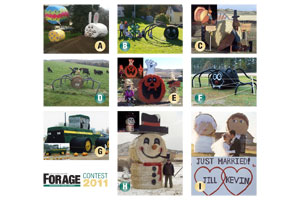 3. 2011 Hay Bale Decorating Contest
3. 2011 Hay Bale Decorating Contest
The voting page for out bale decorating contest was a popular page this season.
Although voting has now ended, click here to view the winners.
Click here or on the image at right to view it at full size in a new window.
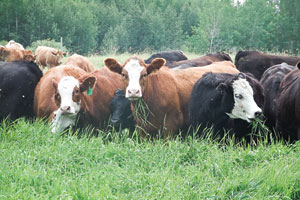 4. Year-round grazing, even in Canada
4. Year-round grazing, even in Canada
Grassland manager Steve Kenyon of Busby, Alberta, is a little unconventional and a whole lot life-oriented.
His family-friendly seminars are about minimum work, maximum profit, being nature-oriented.
Kenyon doesn’t own a tractor. He doesn’t own a ranch.
Click here to view this article in the October 4, 2011 Progressive Forage Grower Extra e-newsletter.
5. Math anxiety: Fertilizer calculations
You may know people who suffer from math anxiety. They avoid situations where mathematics and calculations are required. However, avoiding math is simply not an option when working with agriculture.
The International Plant Nutrition Institute (IPNI) ... in cooperation with university specialists ... has recently published a “how-to” workbook that presents commonly used mathematical concepts in agriculture.
It begins with simple arithmetic and advances all the way to complex modeling.
Click here to view this article in the March 1, 2011 Progressive Forage Grower Extra e-newsletter.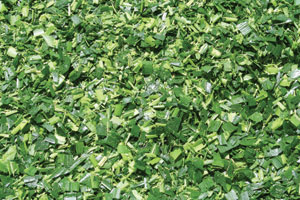 6. Corn silage packing conflict resolution management
6. Corn silage packing conflict resolution management
The conflict: Get the corn silage in before the corn gets too dry, it rains and gets too muddy, the corn goes down in a hurricane or tornado, the corn gets frosted or the cows have to go because there is not enough forage – and pack it correctly.
It takes time to pack silage correctly, and time is a scarce commodity these days. Understanding both what it takes to pack correctly and the consequences of not doing so is critical to resolving the conflict.
Click here to view this article in the October 4, 2011 Progressive Forage Grower Extra e-newsletter.
7. Is it worth the extra resources to grow higher-quality hay?
The question arises often as to which grade of hay is a “better buy” or how does the price for hay compare on a nutrient or feed value basis.
A University of Idaho study looked at a relative cost comparison on two factors, total digestible nutrients (TDN) and crude protein (CP).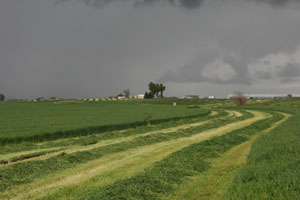 8. Dealing with wet hay
8. Dealing with wet hay
Nobody wants to mess with a wet dog or a wet bale of hay. Baling wet hay can increase moldiness, heat-damage crude protein or occasionally result in hay fires.
This article will discuss the cause of heat production, review methods to determine moisture content before baling and offer possible solutions when curing weather is less than optimal.
Click here to view this article in the June 14, 2011 Progressive Forage Grower Extra e-newsletter.
Our annual forage statistics map that shows a snapshot of forage production in the U.S. during the previous year.
Click here to view the stats in the February 1, 2011 Progressive Forage Grower Extra e-newsletter.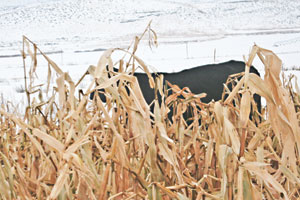 10. Grazing corn
10. Grazing corn
Brown midrib (BMR) is probably the biggest advancement in crop breeding since hybrid corn. While the discovery of BMR at Minnesota in 1924 predates commercial hybrid corn, it has taken a long time to realize its value. BMR increases the value of the non-grain portion of the plant because it reduces lignin, which is indigestible to ruminant animals.
In other words, not only do we have the highly digestible grain portion, but we have also increased the digestibility of the stalk and leaves. The BMR gene is also found and is being utilized in sorghum, sorghum-sudan and pearl millet. FG











